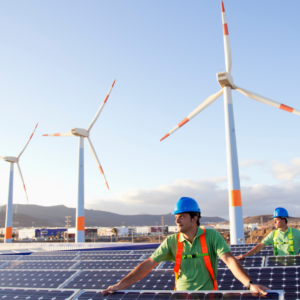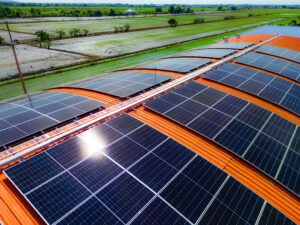Rich in natural resources, Indonesia can expand its prospects by wisely observing its potential and taking steps towards deeper research in renewable energy. However, being rich in natural resources does not mean that Indonesia is prepared to process and maximize the utilization of these resources for the development of renewable energy. Indonesia needs to address several matters if it wants to take further steps in developing renewable energy, such as infrastructure improvement, regulatory readiness, and well-trained and prepared human resources.2
In an effort to draw the attention of young people towards the renewable energy field, the Ministry of Energy and Mineral Resources (ESDM) has launched a website called Renewable Energy Indonesia (REI), developed with the intention of providing people with various information related to renewable energy.1 REI features job vacancies, educational resources, company information, and more to explore within the sphere of renewable energy in Indonesia.1 The information provided can be a potential resource for Indonesia, especially for the young generation, to develop their interest in renewable energy, and with these features and information, REI could play a crucial role in spreading awareness of the potential of renewable energy in Indonesia and is expected to encourage the younger generation to expand and accelerate its adoption.
The potential of renewable energy in Indonesia can be gleaned from comments by the Deputy Chairperson for Maritime Affairs, Investment, and Foreign Affairs of the Indonesian Chamber of Commerce and Industry (Kadin), Shinta Widjaja Kamdani, who says that Indonesia is currently placed as the second largest country with Natural Based Solutions (NBS).2 The natural resources available in Indonesia create significant potential and open up many opportunities for the development of renewable energy.
In terms of its policy and regulatory framework, Indonesia can be seen as quite ambitious, with Government Regulation No. 79 of 2014 targeting renewable energy in the national energy mix at 23% by 2025 and 31% by 2050.3 Human resource factors could also decide the success of renewable energy implementation in Indonesia. To improve the quality of human resources in the renewable energy field, besides the REI, the Ministry of Education, Culture, Research, and Technology has also contributed by massively promoting the latest program from the Internship and Certified Independent Study (MSIB), which is the Solar Electricity Initiative Movement (GERILYA) in collaboration with the Ministry of Energy and Mineral Resources.4 This program aims to foster a young generation that is more familiar and ready to join the workforce in Indonesia’s renewable energy sectors.
As for infrastructure, the National Electricity Company (PLN) has made various efforts to promote the energy transition in Indonesia, ranging from increasing the capacity of renewable energy power plants and encouraging the implementation of co-firing, to providing clean electricity needs through Renewable Energy Certificate (REC) services.5 The realization of installed renewable energy power plant capacity in Indonesia reached 8,786 megawatts (MW) in 2023, an increase of 261 MW compared to 2022’s 8,525 MW.5 Hydropower plants contributed the largest portion with a capacity of 5,777 MW, geothermal power plants contributed 2,519 MW, and the remainder came from solar, wind, and biomass.5According to Bisnis.com, the National Energy Council (DEN) aims for a renewable energy of 70%-72% in the energy mix by 2060.6 Initially targeted at 23% by 2025 and 31% by 2050, the revised national energy policy (PP KEN) now includes nuclear energy.6 As the government transitions towards achieving these targets, it plans to gradually phase out coal and gasoline.6 Indonesia has much to do to achieve its renewable energy targets, but it is on its way.
[1] Indonesia Business Post Journalist, (2024), “ESDM ministry launches ‘Renewable Energy Indonesia’ website,” Indonesia Business Post, July 8. Retrieved: https://indonesiabusinesspost.com/insider/esdm-ministry-launches-renewable-energy-indonesia-website/
[2] Costa, Gusty, (2024), “Indonesia has 3,686 GW renewable energy resource potentials: Kadin,” Indonesia Business Post, July 13. Retrieved: https://indonesiabusinesspost.com/insider/indonesia-has-3686-gw-renewable-energy-resource-potentials-kadin/
[3] Riswantyo, Cindy, (2024), “Indonesian Energy Transition – A Snapshot,” White Case, February 16. Retrieved: https://www.whitecase.com/insight-alert/indonesian-energy-transition-snapshot#:~:text=Amongst%20other%20things%2C%20this%20policy,Agreement%20by%20enacting%20Law%20No.
[4] Ministry of Education, Culture, Research, and Technology, Republic of Indonesia (2023), “An Attempt to Get Students Directly Involved in Renewable Energy Utilization,” Study In Indonesia March 27. Retrieved: https://studyinindonesia.kemdikbud.go.id/web/post/read/an-attempt-to-get-students-directly-involved-in-renewable-energy-utilization
[5] Syofiadi, Rify, (2024), “Pengembangan EBT Tumbuh Positif di 2023, PLN Catatkan Kinerja Yang Berkelanjutan,” PLN, June 4. Retrieved: https://web.pln.co.id/cms/media/siaran-pers/2024/06/pengembangan-ebt-tumbuh-positif-di-2023-pln-catatkan-kinerja-yang-berkelanjutan/
[6] Whayudi, Nyoman, (2024), “Pemerintah Target Bauran Energi Terbarukan (EBT) Sentuh 72% pada 2060,” Bisnis.com, July 8. Retrieved: https://ekonomi.bisnis.com/read/20240708/44/1780476/pemerintah-target-bauran-energi-terbarukan-ebt-sentuh-72-pada-2060






